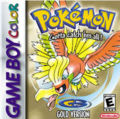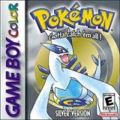Pokémon: Gold and Silver Versions
 
| |
| Pokémon: Gold/Silver Versions | |
| Developer | Game Freak |
| Publisher | Nintendo |
| System | Game Boy Color, 3DS Virtual Console |
| Release Date | Game Boy Color JP November 21, 1999 US October 15, 2000 AU October 16, 2000 EU April 16, 2001 3DS Virtual Console All Regions: September 22, 2017 |
| Rating | ESRB: E |
Pokémon: Gold Version and Pokémon: Silver Version are two different versions of a monster-collecting handheld RPG that begin the second generation of games in the Pokémon series.
Story[edit]
Taking place after the events of the the first generation games, Pokémon Gold and Silver follow the journey of a new aspiring trainer. Like Red, this trainer wants to become a Pokémon master. To accomplish this, the trainer must defeat eight Pokémon gym leaders to earn their badges, then defeat the Elite Four for the champion. Along the way he must compete with his rival, foil the plans of Team Rocket and capture as many of the different species of Pokémon as he can.
Gameplay[edit]
Pokémon Gold and Silver retains and builds upon the basic gameplay scheme that was introduced in the previous generation of games. Most notably, this generation Introduces one hundred new Pokémon species, bringing the total up to 251. Some of these included new evolutions and pre-evolved forms of Pokémon from the first generation games. The games also introduced new Pokémon types (Steel and Dark).
The games heavily utilized an internal clock, and many of the new features revolved around it. Some Pokémon only appeared at certain times of day, and different events would occur on different days of the week. The player had a Pokégear with which the player could make calls to other characters or listen to radio shows.
This generation also introduced the concept of Pokémon breeding. If the player left two compatible Pokémon at the Pokémon Daycare for an hour, an egg would be there when they returned. The egg would hatch into a new Pokémon. This could be used to breed Pokémon with unique starts and/or moves, and it could also be used to acquire several new baby species of Pokémon. Some other new features included the collecting of apricorns (which could be used to make special customized Pokéballs) and the appearances of rare Shiny Pokémon.
Connectivity[edit]
Using the Game Boy Link Cable, games could be connected so that the Pokémon could be traded or used in battle. Some Pokémon could only be obtained through trade: Pokémon that were exclusive to one version as well as Pokémon that could only evolve after being traded. There were also several points in the game were the player had to choose one out of two or more Pokémon to own (such as in the beginning, where the trainer must choose between a Cyndaquil, Totodile or Chikorita), and the Pokémon not chosen could then only be obtained by trading with another player. Pokémon could also be transferred into the games through Nintendo representatives; this was the only method of acquiring Celebi, the hidden 251st Pokémon, without use of glitches or cheating devices.
Gold and Silver could also be linked with the original games for trade through the special "Time Capsule" feature; however, the Gold and Silver players could not trade any of the new Pokémon introduced in those games, nor could they trade Pokémon that knew one of the new moves introduced in Gold and Silver. Finally, these games could be linked to the Pokémon Stadium 2 games on the Nintendo 64, where the Pokémon could be used in 3-D battles, and several unique Pokémon with special moves could be unlocked.
In addition to trading Pokémon, Gold and Silver added a new feature called Mystery Gift. Two players would receive a random item or decoration by using the IR port on the top of their Game Boy Color.
Version Differences[edit]
In all regions, Pokémon Gold and Silver released simultaneously. In order to increase player interactivity, some of the Pokémon species were exclusive to each version. In addition, there were certain Pokémon that could only be found in Pokémon Red, Pokémon Blue, or Pokémon Yellow.
Continuity Notes[edit]
- These games have the strongest continuity links among the initial Pokémon color versions; it is said to take place three years after the first generation games, and nearly all of the characters from the first generation games reappear, along with Kanto (the setting of the first games) being open to the player after completing Johto's Pokémon League. Most of the cast of the first generation, including the original player character, reappear in Kanto and reference the passage of time.
Legacy[edit]
The second generation games inspired several spin-offs, such as Pokémon Puzzle Challenge.
Pokémon from Gold and Silver have also appeared in the Super Smash Bros. games. Most prominently, Pichu appeared in Super Smash Bros. Melee as a playable fighter.
Sequels[edit]
These games were followed up by the third generation games, Pokémon: Ruby and Sapphire Versions.
Remakes/Rereleases[edit]
- In 2001 a third version, Pokémon: Crystal Version was released. The game featured a subplot about Suicune and a man named Eusine who wished to catch it. It also added the Battle Tower, which featured Pokémon Stadium style battles, and the option to choose to play as a girl.
- Years later, these games were remade for the Nintendo DS as Pokémon: HeartGold and SoulSilver Versions.
- The original Gold and Silver were released for download on the Nintendo 3DS through its eShop as part of the 3DS Virtual Console in 2017. These ports were only slightly modified, with the Nintendo 3DS wireless communication was used for connectivity in place of the Link Cables. The Time Capsule and Mystery Gift features could also still be used with other copies of the Virtual Console Pokémon releases. The Poké Transporter app could also be used to transfer Pokémon caught in these versions to the Poké Bank, from which they could be brought to other Pokémon games.
| Mainstream titles of the Pokémon Series |
|---|
| I: Red/Green/Blue (Yellow - FireRed/LeafGreen - Let's Go, Eevee/Pikachu!) - II: Gold/Silver (Crystal - HeartGold/SoulSilver) III: Ruby/Sapphire (Emerald - Omega Ruby/Alpha Sapphire) - IV: Diamond/Pearl (Platinum - Brilliant Diamond/Shining Pearl) - V: Black/White (2) VI: X/Y - VII: Sun/Moon (Ultra) - VIII: Sword/Shield - Pokémon Legends: Arceus - IX: Scarlet/Violet |